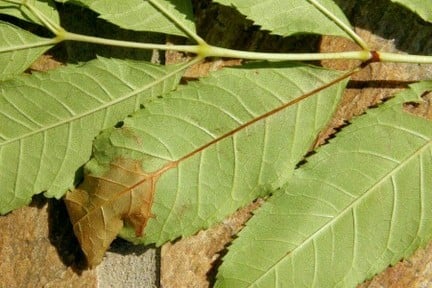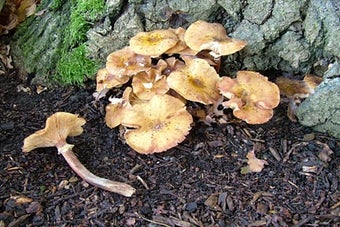
Quick facts
Common name - Ash dieback
Scientific names - Hymenoscyphus fraxineus (sexual stage), Chalara fraxinea (asexual stage)
Plants affected - Fraxinus spp especially F. excelsior and F. angustifolia
Main symptoms - Necrotic lesions in the bark and xylem, crown dieback of trees, leaf loss
Caused by - Fungus
Timing - Spores active June to October
What is ash dieback?
Ash dieback is a serious disease of ash trees, caused by a fungus now called Hymenoscyphus fraxineus. The fungus was described as a new fungal species in 2006 as the cause of ash (Fraxinus excelsior) mortality in European countries during the previous ten years.
The disease affects trees of all ages. Young trees can be killed in one season and older trees tend to succumb after several seasons of infection. Whilst ash dieback is certainly capable of killing trees in its own right, in many cases the weakened tree is colonised by another pathogen, particularly honey fungus, which then accelerates the decline and death of the tree.
Ash dieback has spread rapidly in continental Europe. In the UK, the disease was first confirmed in trees growing in nurseries or on recently planted ash trees. However, many cases have now been confirmed in the wider environment in the UK and the disease is widely distributed. The latest distribution maps for cases of the disease in the wider environment can be found on the Forestry Commission website.
The disease is also established in many other European countries, where it has had devastating effects. The natural host range of the fungus includes F. excelsior,F. angustifolia, F. ornus, F. nigra, F. pennsylvanica, F. americana and F. mandschurica. The least susceptible species are F. americana and F. mandschurica.
In 2018 ash dieback was found infecting three new ornamental tree and shrub species in the UK. These species; mock privet (Phillyrea latifolia), narrow-leaved mock privet (Phillyrea angustifolia) and white fringe tree (Chionanthus virginicus) are in the same family as ash (Oleaceae). These findings are unlikely to have a big impact on the environment as these plants are not or widespread in the UK.
Note: Ash dieback does not affect mountain ash (Sorbus aucuparia). Ash (Fraxinus excelsiorand other species of Fraxinus) can be recognised by the following features;
- Opposing and branches
- Non-waxy grey/brown
- Noticeably black winter buds
- Compound leaves which may be smooth or have finely toothed edges
- 8-12 leaflets depending on species
Useful images of both ash and ash dieback disease can be found on the Forestry Commission website. Images of ash dieback on ornamental species can be found here.
Symptoms
Symptoms of ash dieback include;
- On leaves: Black blotches appear, often at the leaf base and midrib. Affected leaves wilt
- On stems and branches: Small lens-shaped lesions or necrotic spots appear on the of stems and branches and enlarge to form cankers. The infection may girdle the stem and kill it in a single season. If the bark is peeled, the wood underneath has a brownish to grey discolouration. This discolouration extends beyond the bark necrosis
- On stem bases: Some trees affected by the disease develop dark lesions at the bottom of the trunk (known as basal lesions), sometimes in the absence of leaf symptoms or lesions higher up the tree. These basal lesions can cause a more rapid decline of the tree and can also make it unstable
- On the whole tree: Affected trees commonly show extensive dieback of shoots, twigs and branches. Trees often have prolific epicormic shoots (shoots produced from previously below the bark of the trunk or branches).
Control
Non-chemical control
If you find a suspected case of ash dieback in an area where it has not previously been reported (see the distribution map on the Forestry Commission website) you should report your suspicions to the relevant plant health authority by submitting a report via TreeAlert. Sightings in Northern Ireland should be reported via TreeCheck.
Because a tree affected by ash dieback may become structurally unsound, owners of affected trees need to be aware of their liabilities with respect to any damage or injury to third parties or their property that could be caused, should the tree or part of it fall. There is detailed information on both the tree owner's responsibilities, and on appropriate management of affected trees, in this guide from the Tree Council.
This online government guidance on managing ash dieback in England contains links to many other guides and information sources, as well as links to appropriate guidance for Scotland, Wales and Northern Ireland.
Collecting leaves and leafmould
If ash leaves in an area where ash dieback is known to be present, the Forestry Commission recommends covering them with with a 10cm (4-inch) layer of soil or a 15-30cm (6-12 inches) layer of other plant material, and leaving the heap undisturbed for a year (other than covering it with more material). This is likely to prevent any spore dispersal and may help to slow the spread of the disease in an affected area.
Chemical control
There is no chemical control available to gardeners for this disease.
Biology
Hymenoscyphus fraxineus has been isolated from the roots of symptomatic trees, as well as from leaves, shoots and branch/stem lesions.
The infectious spores (sexual) of the fungus are produced by fruiting bodies (apothecia) and can be wind-blown over long distances (20-30 km). The apothecia are produced from June to October on ash leaf petioles and rachises (stalks) from the previous year in the leaf litter. The spores land on leaves or other parts of the trees. From the leaves, the fungus makes its way down the petioles, rachises and stems.
The fungus can also produce asexual spores, but these are not believed to be infectious and can only spread over short distances by water splash. When it is producing asexual spores the fungus is known as Chalara fraxinea, and the disease is therefore sometimes called Chalara dieback or just Chalara.
How does it spread?
The fungus has several pathways of spread over long distances;
It can be spread through the movement of diseased ash plants and logs or unsawn wood from infected trees. Until a ban was applied on all movement of ash trees and seeds in October 2012, high volumes of ash (F. excelsior) were imported every year either for forestry or non-forestry purposes; therefore the potential for entry of the pathogen to the UK was very high.
However, the theory that spores wind-blown from the continent are a common source of entry is now widely accepted, as cases recorded in the wider environment were initially located in the eastern parts of the country. The density of wider environment infections is still greatest in the east but there have now also been cases recorded in many other areas. Because the disease is now so widespread the movement ban on ash within the UK and from EU countries has now been lifted.
The fungus is also seed-borne.
Other pests and diseases of ash
Dieback on ash can also be the result of an infection by several wood decay fungi and also by the root pathogen honey fungus. These fungi can also affect trees that are already suffering from Hymenoscyphus fraxineus. Cankers caused by the fungus Neonectria ditissima and the bacterium Pseudomonas savastanoi pv. fraxini are also associated with dieback on ash. The latter disease has only been confirmed on Fraxinus excelsior.
The pest ash moth (Prays fraxinella) affects Fraxinus excelsior causing hollowing out of and removal of at the base of shoots, sometimes leading to shoot killing. The damage is usually seen in May.



